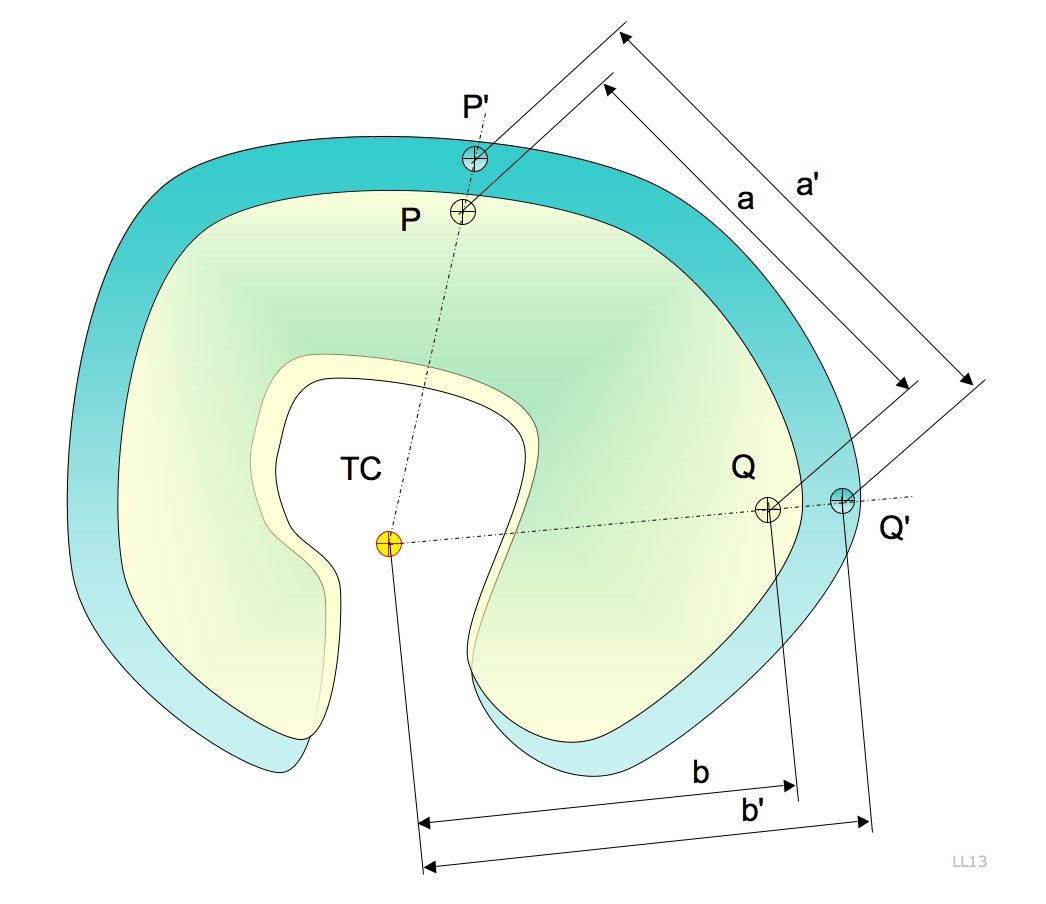Thermal Center on:
[Wikipedia]
[Google]
[Amazon]
 The thermal center is a concept used in applied mechanics and
The thermal center is a concept used in applied mechanics and
 The thermal center is defined under the following hypothesis:
*A solid body with homogeneous and isotropic thermal properties;
* Isostatically constrained;
*A thermal variation ΔT is applied to the entire body.
The thermal variation will produce an expansion of the body: this means that for each couple of points P and Q the distance will become:
where , is the coefficient of thermal expansion.
Analyzing this phenomenon in an absolute coordinate system, the transformation of the solid body is a geometrical similarity.
It is possible that, choosing the constrains conveniently, one point belonging to the space associated to the body will not move during the thermal variation: this point is called thermal center. In this case, the geometrical similarity becomes a
The thermal center is defined under the following hypothesis:
*A solid body with homogeneous and isotropic thermal properties;
* Isostatically constrained;
*A thermal variation ΔT is applied to the entire body.
The thermal variation will produce an expansion of the body: this means that for each couple of points P and Q the distance will become:
where , is the coefficient of thermal expansion.
Analyzing this phenomenon in an absolute coordinate system, the transformation of the solid body is a geometrical similarity.
It is possible that, choosing the constrains conveniently, one point belonging to the space associated to the body will not move during the thermal variation: this point is called thermal center. In this case, the geometrical similarity becomes a
 The thermal center is a concept used in applied mechanics and
The thermal center is a concept used in applied mechanics and engineering
Engineering is the practice of using natural science, mathematics, and the engineering design process to Problem solving#Engineering, solve problems within technology, increase efficiency and productivity, and improve Systems engineering, s ...
. When a solid body is exposed to a thermal variation, an expansion will occur, changing the dimensions and potentially the shape of the body and the position of its points. Under certain circumstances it may happen that one point belonging to the space associated to the body has no displacement at all: this point is called the thermal center (TC).Soemers, "Design principles for precision mechanisms", p. 58.
Applications
The thermal center position is not affected by a thermal expansion: this property makes the TC a very interesting point in those applications where it is important that thermal variations have no effects on a certain process. Photolitography machines and high precision optical instruments are some examples of application of this concept.Definition
 The thermal center is defined under the following hypothesis:
*A solid body with homogeneous and isotropic thermal properties;
* Isostatically constrained;
*A thermal variation ΔT is applied to the entire body.
The thermal variation will produce an expansion of the body: this means that for each couple of points P and Q the distance will become:
where , is the coefficient of thermal expansion.
Analyzing this phenomenon in an absolute coordinate system, the transformation of the solid body is a geometrical similarity.
It is possible that, choosing the constrains conveniently, one point belonging to the space associated to the body will not move during the thermal variation: this point is called thermal center. In this case, the geometrical similarity becomes a
The thermal center is defined under the following hypothesis:
*A solid body with homogeneous and isotropic thermal properties;
* Isostatically constrained;
*A thermal variation ΔT is applied to the entire body.
The thermal variation will produce an expansion of the body: this means that for each couple of points P and Q the distance will become:
where , is the coefficient of thermal expansion.
Analyzing this phenomenon in an absolute coordinate system, the transformation of the solid body is a geometrical similarity.
It is possible that, choosing the constrains conveniently, one point belonging to the space associated to the body will not move during the thermal variation: this point is called thermal center. In this case, the geometrical similarity becomes a homothety
In mathematics, a homothety (or homothecy, or homogeneous dilation) is a transformation of an affine space determined by a point called its ''center'' and a nonzero number called its ''ratio'', which sends point to a point by the rule,
: \o ...
and the thermal center is the center of the homothety itself.
The thermal center does not always exist. The TC is a function of the constraints. Picture B shows an example where the geometry of the constraints doesn't come to a unique point.
The TC may exist even if the body has non-homogeneous isotropic thermal properties, but when this condition is not verified, it's not possible to determine its position by using the simple geometric method shown above, and the transformation will not be a homothety.
See also
*Thermal expansion
Thermal expansion is the tendency of matter to increase in length, area, or volume, changing its size and density, in response to an increase in temperature (usually excluding phase transitions).
Substances usually contract with decreasing temp ...
Notes
References
* Soemers, Herman. ''Design principles for precision mechanisms''. T-Pointprint. *(nl) Koster, M.P. ''Constructieprincipes voor het nauwkeurig bewegen en positioneren''. {{ISBN, 978-90-5574-610-1. Mechanics